Maria Stanovoi: Sighthound is a Hunting Dog
“A sighthound, being itself a weapon of its kind, that has to think while hunting (it is not like a simple-minded hound or pointer), is a priceless gem, which, when converted in a pet, communicates at a very high level with its owner, and such a communication is absolutely unique and different from that achieved with any other breed used for centuries to carry out only a couple of simple activities… “
Dr. Maria Stanovoi
Since my childhood in my native, Russia, I have been interested in biology, hunting, and cynology. Both of my grandfathers were hunters; my paternal grandfather hunted exclusively with Laikas, while my maternal grandfather preferred Setters. I, however, was captivated by sighthounds. I was initially unable to afford the upkeep of a large dog, so started with Dachshunds, and it was not until 1991 that I welcomed my first Hortaya Borzaya into my life. Due to my involvement in hunting and cynological activities, I have maintained close connections with others sharing these interests in Russia and the ex-Soviet Asian states. When my current Hortayas, living in the Czech Republic, are of age, I plan to visit my friends and partake in traditional hunting – the most ancient collaboration of man and dog.
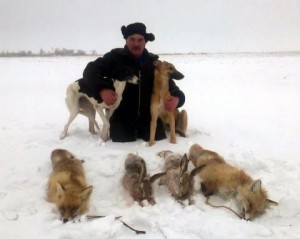
After hunt: A hunter and his Hortayas
HISTORICAL ROOTS
Sighthounds have been living and hunting with men in vast steppes of South-East Europe and Asia since time immemorial. In 4th century AD, Herodotus wrote about Scythians from the East European steppes and their hunting dogs, tracking and catching game for their masters. In Scythian tombs, found in today’s Ukraine, jewellery depicting sighthounds has been discovered, and archaeological excavations have revealed sighthound bones. Two thousand years ago, sighthounds were also bred by the Celts living in regions extending from the British Isles to China. Songs are sung today about a ”Shooter Ivashenko, leading a Hortaya“, dating to the pre-Christian (about one thousand years ago). Political and cultural contact between the southern part of Russia and Ukraine, and the Muslim world, famous for the breeding of Asian sighthounds, was strong for centuries. Until the October Revolution of 1917, traditional spring and autumn fairs took place; Asian merchants brought goods of all sorts, as well as livestock, for sale and trade. Here, hunters and breeders would be able to buy and trade sighthounds, too: Tyszkiewicz (1881) mentioned that Polish hunters used to obtain excellent sighthounds at Ukranian fairs.
Due to a different economic system, hunting with sighthounds in Western Europe was the pastime of the aristocracy, and had a relatively short history. The tall tales associated with this manner of hunting are astounding; typical for any “exotic” or romanticised activity with neither traditions nor roots in the common European dog lovers´ of hunters’ worlds. In the regions of the world where hunting with hounds has been practised for eons, in the steppes of southern Russia and Ukraine, the barren expanses of Central Asia, and the Arabian and North African countries, this activity still features in the daily life of the common folk. In such places, most sighthound keeps are average people, and even today their sighthounds are an important means of getting food on their tables.
HUNTING WITH SIGHTHOUNDS IN THE COURSE OF THE HISTORY
Hunters and cynologists usually base their idea of hunting with sighthounds in the then Russian empire on literature or movies depicting life of Russian noblemen from the North-European regions of Russia, who used to breed a longhaired Russian sighthound – the Russian Borzoi. Within the framework of the general system of hunting with hounds and longhaired sighthounds, such hunting is a new “invention“ requiring rather high financial investments by those who performed such activities. In large kennels, often up to 1,500 sighthounds and other dogs were kept. These required an entire army of staff to care for them. The hunting event as such used to be a spectacular theatre play with many actors and spectators. A pack of scenthounds was employed, often singing in a pleasant manner, to beat game from wooded areas into small meadows, where the tired game was faced with Russian Borzoi, which had been transported there on carts.

Spectacular events are organised nowadays to celebrate Russian traditions
In the majority of the cases, foxes and hares were objectives of such hunts; frequently, also wolf hunts were organised. The majority of Borzoi breeders considered the catching of a wolf to be the most important success of their dogs of which they used to boast. However, this is a big “mistake“: In fact, the Borzois never really hunted or caught any wolves. To catch a prey means to pursue it and kill it, which, in the case of Borzois, is possible only when hunting animals such as the fox, hare, or smaller ungulates. In the above-described hunt, the hounds drove the wolf into a meadow, and the task of the sighthounds was to close the wolf in and keep it in the place until the hunter came. The hunter had to perform a special task: on horseback, the hunter got close to the wolf standing in a defence posture, in the appropriate moment, the hunter jumped off the horse at the wolf’s back, catching the animal by its ears, immobilising it. If the hunters wished to catch the wolf alive, a wooden stick was stuck between its jaws and the wolf was tied down. If that was not the case, the hunter killed the wolf with one stab of a knife. That was the art of wolf hunting – the man was the hunter. The literature about hunting with sighthounds and the sighthound breeders mention only two dogs in the course of the history that were capable of stopping the wolf, grab it by its nape or skin behind its ears and hold it until hunters came. The name of the first one was “Game,” the result of an Irish Wolfhound and Borzoi cross. The second one was an offspring of a large shepherd dog capable of killing a wolf.
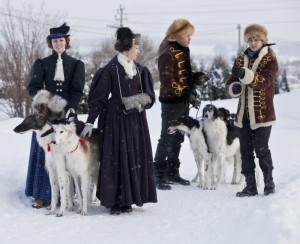
Russian Borzoi - an inseparable part of the Russian history
After the October Revolution in 1917, traditional manners of hunting, including wolf hunting, disappeared with the noblemen, and Russian Borzois, important for such hunting, became nearly extinct. The breeding of this breed was more or less destroyed; many crosses of dogs coming from the large abolished kennels appeared. Only some breeders form large towns still owned a really limited number of purebred Borzois. The population of longhaired Russian Borzois began to prosper again after World War II, thanks to specimens newly imported from abroad. However, traditional wolf hunting has disappeared completely from the European regions of Russia and Ukraine. Hunting with firearms is easier. Furthermore, there is hardly a breeder to be found nowadays willing to maintain large kennels, and to mercilessly expose hundreds of sighthounds to wolves´ teeth just in order to breed one dog capable of immobilising a wolf.
For the sake of the tradition, some hunting centres still organise so-called sighthound tests of sharpness to the wolf. I have been told that in the last twenty years approximately four sighthounds succeeded in passing this test in Russia. Two of them were siblings, Hortaya Borzaya males, that obtained third class certificates for working in a pair, and one or two Russian Borzois. I am sure that one Russian Borzoi has obtained the second class certificate (the dog tried to hold the wolf by the skin on the withers, however it did not succeed); I am not sure about the other dog. According to the examination procedure rules, the sharpness test is usually performed without any contact between the animals: the behaviour of the sighthound in the presence of the wolf is assessed. The only injury suffered in such a test is the pride of the owner of the most intelligent sighthound, which refuses even to give the wolf a single look. The wolf is a clever, strong and dangerous animal with super-fast reactions, able to defend itself and attack perfectly. Every sighthound that suffers an injury or dies just for the entertainment of its ambitious owner is a real waste.
Life and traditional hunting with sighthounds is very different in the rest of Eurasia – in the original lands of such dogs – the steppes. In the South of Russia, a part of Ukraine and Asia, sighthounds have remained the primary hunting dogs. For their owners, sighthounds are important supporters of their families. Nobody owns more than two packs, consisting of three dogs each, which means six sighthounds are usually the maximum number of dogs per hunter and breeder. The hunter usually goes hunting on foot or on horseback, taking with him/her one, or more often, a pair of sighthounds. Quite often, the hunter’s family lives on the result of the hunt.
In spite of a complicated past, sighthound breeds have survived in their regions of origin until today. They continue working and hunting with joy for their enthusiastic owners, and the breeding of such sighthounds has been gradually extending also outside the borders of the ex-Soviet republics.
CHARACTERISTICS OF HUNTING SIGHTHOUNDS
A hunting sighthound must have several capabilities that are impossible to test in racing or coursing. It must be able to run across different kinds of surfaces, from a turned-up field through thicket up to rocky glens – places through which the prey escapes. It must have stamina. In Central Asia, the Tazy is expected to chase small ungulates for distances up to 15 km before they can be caught, and then, they must dispatch the prey and continue hunting. However, not ever hunt has a successful outcome – it depends on the quality of the prey. The healthier and more experienced the game is, the lesser the chance the sighthound has to catch it. The sighthound must be able to run at least half a dozen times, following its prey during the course of a day. Hunts take place from dusk to dawn, at least for three months of the year: in the European part of Russia, the hunting season takes place from November to February, while in some Russian regions the season of hunting with sighthounds is prolonged to six months, from autumn to spring. The traditional rule has it that the hunting with sighthounds starts one week earlier than hunting with firearms.
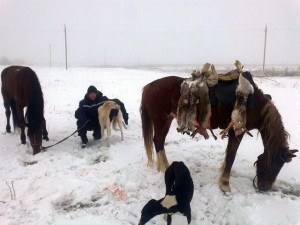
Hortayas after the hunt - Saratov Region, Ukraine
The capability of working on fresh track is an important hunting capability of Russian-Asian sighthounds. This task is included in the sighthound hunting tests. When the game escapes out of sight, almost every Hortaya, Stepnaya, Tazy or Taigan immediately starts sniffing and following it. The Russian Borzoi has an inferior ”nose“ and also its style of working has always been and continues being different from the requirements for hunting sighthounds used in regions of the previous Russian Empire and Soviet Union. Russian Borzois are also the most affected by breeding for beauty and the showring.
The Taigans have unique characters and working capabilities. They are traditional hunting dogs of shepherds living along the dangerous slopes of the Kyrgyz mountains. They live with their owners in isolated places and must function as guardians as well. The Taigan is the only sighthound which can hold with loud barking, a Siberian ibex (Capra sibirica) in place until its owner comes and kills it. The Taigan is also the only one of the existing sighthounds capable of catching a wolf. First, it cuts off the wolf’s tendons on hind legs and after that, it bites its throat. It is necessary to point out, however, that wolves living in the Kyrgyz region are smaller and lighter than European wolves.
Naturally, a hunting sighthound must be intelligent, as it takes more than speed to catch prey – the dog must know the game’s movements and character; the best hunting results are achieved by dogs from six to ten years of age. Successful older sighthounds become famous and breeders include them in breeding programmes more often, thus automatically selecting for longevity and good health.
A COUPLE OF REMARKS ON SIGHTHOUND TRAINING
The timeless manner of keeping and rearing hounds persists today: culling is practised, in the case that an animal fails to meet the needs of its keeper. An animal with temperament problems, whether displaying shyness, aggression, or the tendency to chase or kill domestic livestock, is immediately disposed of. Few, if any, hunters care to keep a dog solely for its beauty, for the need to hunt and provide meat for the family is very real. Veterinary care is exceedingly difficult to come by, and as such, natural genetic health and vigour are essential for the survival of the dog.
The sighthound co-operates closely with man during the hunt. It searches the landscape in the pointed direction, it retrieves the prey or leads the hunter towards it. Sighthounds often hunt in pairs, where one dog stays by the prey while the other returns to the hunter and leads him/her to the prey. The hunting sighthound should not leave the killed prey and go on searching for other quarry. Hounds with such a tendency are culled. Such a defect may be discovered only in hunts or tests. For every sighthound, it is obligatory to pass field hare or fox hunting trials in order to obtain a breeding permit issued by clubs of the Russian Hunting Cynological Association created in 1862, an organisation which became the founding member of the Russian Cynological Federation – an FCI member.

Kazakh Tazy
Sighthounds are the only dogs that do not require any training with live or artificial prey prior the examination or hunting. Good physical condition and communication with its leader are fully sufficient. I am always a bit bothered by stories of sighthounds that escape from their poor owners! Defects caused by a neglected training of a dog by its owner will be mentioned further on. Therefore, I will answer this with a question: What would be a hunting dog that does not return to its owner good for? Even a well-trained German Shepherd escapes from an incompetent owner!
ENVIRONMENT-FRIENDLY MANNER OF HUNTING
In the 1980s, the Institute of Ecology, Morphology and Ethology of Animals of the Russian Academy of Sciences carried out research into the comparison of the health condition and quality of game hunted with firearms and with help of sighthounds. More than 80% out of the shot hares had no health problems before being shot; in less than 20% of them, different deviations from normal conditions were found (previous injury, development defects, parasites, different illnesses and defects). In the case of hares caught by sighthounds, it was discovered that 90 % out of the total suffered from different health problems, either visible at first sight or detectable in a scientific laboratory.
The research revealed the fact that the sighthound may reach and catch only prey with a defect, so that both quality and quantity is controlled by Nature itself. Such a unique characteristic of sighthounds was used in the reproduction and re-introduction of an endangered population of goitered gazelle (Gazella subgutturosa) in its areas of origin in the Bukhara Nature Preserve, Uzbekistan, which had become practically extinct due to hunting with firearms. In the preserve, a “sighthound health-control unit“– a hunting pack composed of Hortaya Borzaya and Tazy breeds - is actively used by the Preserve staff for regular hunting, thus carrying out a selection of a breeding herd of healthy gazelles without a necessity of high costs, however with great success.
I can provide another example of the positive impact of hunting with sighthounds. My friend is a sighthound performance judge, and she runs a sighthound training and hunting centre in the steppe in the South of Russia. Hares hunted by sighthounds ten years ago in that area were small animals hardly weighting 3 kg, and they were easy to catch. Hunters from neighbouring villages used to make jokes of hares dying out before their very eyes, not being “as they used to be“, saying there was no sense in hunting such animals, not to say even with sighthounds. They used to claim that in a couple of years, no hare would probably be left in the area. After ten years of hunting only with sighthounds, hares from that region weight from 5 to 6 kg, and they give the sighthounds quite a chase. The sighthound, if it is to catch such a hare, is required to call upon all its skill and experience. A healthy and strong animal always escapes from the dogs and helps to improve the population. It is possible to observe contrary impacts when hunting is performed with firearms: the hunter usually tries to shoot the strongest trophy piece, thus impacting automatically the quality of the game population in a negative manner. Hunting with sighthounds has positive impacts on the game, and in areas where it is performed, results in healthier, abundant game.
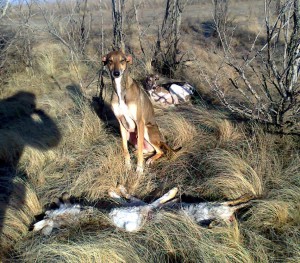
Hortayas after the hunt, Saratov Region, Ukraine
Man is the only species that hunts for pleasure – and as hunting with sighthounds lost its appeal, so hunting with firearms became popular. However, stray bullets contaminate the area in which they are dispersed to such a degree (with lead poisoning) that the health and productivity of the ecosystem is severely compromised. The only “contamination” when hunting with sighthounds, is excrement. Furthermore, no injury is caused by sighthounds where the wounded animal is not eventually tracked, caught, and killed. The game is either caught or killed on the spot, or it escapes unharmed. Hunting with sighthounds, emulating the natural predator-prey relationship, is absolutely environmentally friendly. Hunting in this manner does not lead to the extermination of prey species, which is often the result of hunting with firearms. Hunting with sighthounds also increases the quality of the prey population itself, as it in turn encourages the “survival of the fittest.”
Pictures© With the permission of the authors, courtesy of Dr. Maria Stanovoi
________________________________________________________________
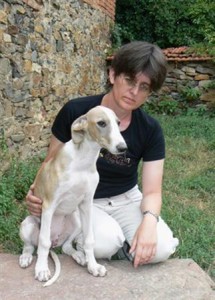
MVDr. Maria Stanovoi is a Russian veterinary doctor, currently living and working in the Czech Republic. Since 1981, she has been breeding smooth Dachshunds and since 1991, a rare sighthound breed – Hortaya Borzaya. She has had the possibility to participate in hunts in Russia with her dogs, being able to study the impact of hunting with sighthounds on the local wildlife. She writes articles about genetics and dogbreeding, and she enjoys drawing pictures and caricatures of different animals. Besides Russian, she also speaks Czech, English and Hebrew.
For visiting Dr. Stanovoi´s web page click here.




